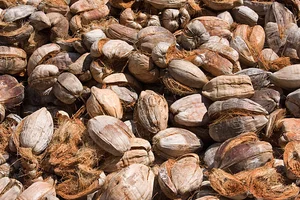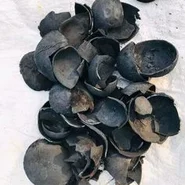Shell of Coconut, often overlooked leftovers from the beloved tropical fruit, have many uses beyond their primary purpose. From traditional practices deeply embedded in culture to innovative eco-friendly solutions, the humble coconut shell embodies sustainability and versatility like no other natural resource. Coconut shell is used for various purposes.
Introduction to Coconut Shell
What is Coconut Shell?
Coconut shell is the hard, outer layer of the coconut fruit, which contains the seeds. Coconut shell are famous for their sturdy composition, protective function and distinctive appearance.
Importance of Coconut Shell :
The shell of coconut acts as a protective covering for the coconut seed, protecting it from external elememts and providing it with the nutrients it needs for germination. Coconut shell extend their significance beyond mere protection, as they are associated with various cultural practices and modern inventions.
Use of Coconut Shell
Traditional Applications : In many tropical regions, coconut shell have traditionlly been used as utensils for cooking and serving food. Their natural durability and heat resistance make them ideal containers for both culinary and cultural purposes.
Handicrafts and Artifacts : Artisans have long used coconut shell for its aesthetic appeal and functionlity, creating intricate handicrafts and patterns. From jewelry to home decor, coconut shell creations showcase the beauty of natural materials and traditional craftsmanship.
Modern Eco-Friendly Option : As the world looks for sustainable alternatives to plastic and other harmful materials, coconut shell has emerged as an eco-friendly alternative. Products like coconut bowls, containers and even cosmetic packaging offer stylish and sustainable choices for eco-conscious consumers.
Industrial Use : Beyond handicrafts, coconut shell finds practical applications in various industries. Their high lignin content makes them suitable for the production of activated carbon, water filtration systems, coconut shell are used in most mattresses, and even as a renewable energy source through biomass conversion.
Benefits of Coconut Shell
Durability : Shell of coconut is a renewable resource, millions of coconuts are harvested worldwide every year. The biodegradable nature of coconut shell ensures minimal environmental impact, making them an eco-conscious choice for consumers and industry alike. Despite their lightweight and organic structure, coconut shell boast remarkable durability. Whether as kitchenware, construction material or artistic medium, their resilience ensures longevity and practicality.
Versatility : From household items to industrial materials, coconut shell exhibits remarkable versatility. Their inherent properties adapt them to different applications, encouraging innovation and creativity in various fields. Coconut shells are used as fuel, coconut shells mixed with neem leaves are used to rupel mosquitoes and flies in rural areas, coconut shells are used to make coconut rope.
Coconut Shell Charcoal :
1. Collecting Coconut Shell : Start by gathering coconut shell from fresh coconuts. Ensure that the shell are clean and free any contaminants or residues.
2. Drying the Coconut Shell : Allow the collected coconut shell to dry thoroughly in the sun or in a well-ventilated area. Drying the shell helps remove moisture , making them easier to process and reducing the risk of mold or decay.
3. Breaking Down the Shell : Once the coconut shell are completely dry, break them down into smaller pieces using a hammer or a machete. Aim for pieces roughly the size of a fist, as smaller pieces facilitate uniform carbonization.
4. Cooling and Stabilizing : Aftre the carbonization process is complete, allow the charcoal to cool down gradually. Once cooled, remove the charcoal from the kiln or drum and let it stabilize for a new days. Stabilization helps improve the quality and durability of the charcoal.
5. Carbonization Process : Place the broken coconut shell pieces in a metal drum or a kiln specially designed for carbonization. Heat the shell at high temperatures ( around 500-600° C) in the absence of oxygen. This process, Known as pyrolysis, converts the organic material in the shell into charcoal while releasing volatile compounds as gases.
6. Sieving and Grading : Sieve the charcoal to remove any impurities or large particles. Grading the charcoal ensures uniformity in size and quality, making it suitable for various applications.
7. Packaging and Storage : Pack the sieved and graded coconut shell charcoal into airtight containers or bags to maintain its quality and prevent moisture absorption. Store the charcoal in a cool, dry place away from direct sunlight.
8. Utilizing Coconut Shell Charcoal : Now that high quality coconut shell charcoal is made, one can enjoy its numerous benefits :
A. Eco-Friendly Fuel : Use coconut shell charcoal as a clean and sustainable alternative to conventional charcoal or wood.
B. Water Filtration : Activated charcoal made from coconut shell is highly effective in purifying water by absorbing impurities and pollutants.
C. Soil Amendment : Add charcoal to the soil to improve soil structure, water retention and nutrient availability for healthy plant growth.
D. Odor Absorption : Place coconut shell charcoal in closets, refrigerators or other enclosed spaces to absorb unpleasant odors and moisture.
Recycling and environmental Impact
Biodegradability : Unlike synthetic materials that persist in the environment for centuries, coconut shell decompose naturally, reducing pollution and ecosystem disruption. Their biodegradability makes them an attractive to conventional plastics and packaging materials.
Upcycling Initiatives : Communities and businesses worldwide are harnessing the potential of coconut shell through upcycling initiatives by reusing discarded shell into value-added products, these initiatives not only reduce waste but also create economic opportunities and promote sustainable development.
Conclusion
The versatile and sustainable nature shell of coconut makes them a valuable resource with untapped potential. From traditional practices rooted in culture to modern innovations that drive environmental stewards, coconut shell exemplify the harmony between human ingenuity and natural abundance. By embracing the myriad uses of coconut shell and supporting initiatives that encourage their responsible use, we contribute to a greener, more sustainable future for generations to come.
FAQs
Are coconut Shells compostable?
Coconut shells are biodegradable and can by composted to enrich soil fertility.
Can coconut shells be used as fuel?
Yes, coconut shells can be utilized as biomass fuel through carbonization or gasification processes.
Are coconut shell products dishwasher safe?
While coconut shell products are generally durable, it’s advisable to hand wash them to prolong their lifespan and preserve their natural finish.
Do coconut shell products have a distinct odor?
Initially, coconut shell products may retain a subtle aroma, but with proper cleaning and use, any residual scent typically dissipates over time.
Are coconut shell products suitable for hot beverages?
Yes, coconut shell cups and mugs are heat-resistant and can safely hold hot liquids. It’s recommended to avoid prolonged exposure to exposure to extreme tempetatures to prevent damage.



